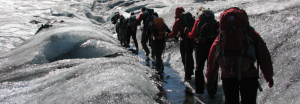GIS in Tourism and Recreational Planning
With increased tourism worldwide it has become increasingly important to recognize and understand various impact of tourism. Tourism needs to be planned and managed to sustain the tourist attraction, and this is particularly true in natural area tourism where the natural attraction underpin the economic benefit of tourism. Understanding the cause and types of environmental impact caused by tourism is critical in the planning, development and management of natural area tourism. Geographical information systems (GIS) facilitates the monitoring and planning processes and are essential in documenting and analyzing the suitability of different resources for tourism.
This course exemplifies the use of GIS as a tool for handling multiple issues in relation to natural area tourism.
Tourist statistics is analyzed regarding seasonality and regionality. Zoning of sensitive/protectable cores within Iceland’s first geopark, Katla Geopark, is achieved by analyzing ecological sensitivity, wilderness and protected areas which in the final module is combined into a Tourism Decision Support System (TDSS). The final task is mapping the location of highly protectable cores where tourism would need restriction and special management attention.
This course includes both theoretical lectures/literature as well as practical exercises in capturing and analyzing spatial data specific to tourism planning and management. Theoretical examination is based on the course book; Natural Area Tourism, -Ecology, Impacts and Management- and is provided as an e-book that can be borrowed from the Geo-library at Lund University.
detailed description
For more information, click here.
